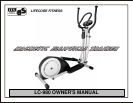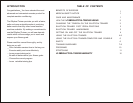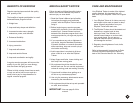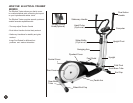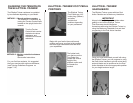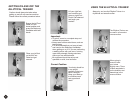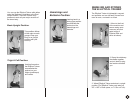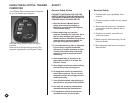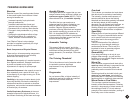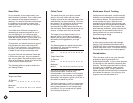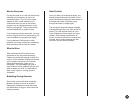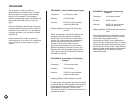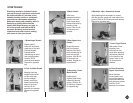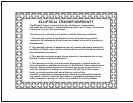
Exercise
Exercise is one of the most important factors
in the overall health of an individual. Listed
among its benefits are:
Increased capacity for physical work
(strength endurance)
Increased cardiovascular (heart and
arteries/veins) and respiratory efficiency
Decreased risk of coronary heart disease
Changes in body metabolism, e.g. losing
weight
Delaying the physiological effects of age
Physiological effects, e.g. reduction in
stress, increase in self-confidence, etc.
Your Elliptical Trainer's unique design
provides an excellent opportunity for a high
level of overall fitness.
Basic Components of Physical Fitness
There are four all encompassing components
of physical fitness and we need to briefly
define each and clarify its role.
Strength is the capacity of a muscle to exert a
force against resistance. Strength contributes
to power and speed and is of great
importance to a majority of sports people.
Muscular Endurance is the capacity to exert a
force repeatedly over a period of time, e.g. it
is the capacity of your legs to carry you 10 Km
without stopping.
Flexibility is the range of motion about a joint.
Improving flexibility involves the stretching of
muscles and tendons to maintain or increase
suppleness, and provides increased resistance
to muscle injury or soreness.
Cardio-Respiratory Endurance is the most
essential component of physical fitness. It is
the efficient functioning of the heart and lungs.
Aerobic Fitness
The largest amount of oxygen that you can
use per minute during exercise is called your
maximum oxygen uptake (MVO2). This is
often referred to as your aerobic capacity.
The effort that you can exert over a
prolonged period of time is limited by your
ability to deliver oxygen to the working
muscles. Regular vigorous exercise
produces a training effect that can increase
your aerobic capacity by as much as 20 to
30%. An increased MVO2 indicates an
increased ability of the heart to pump blood,
of the lungs to ventilate oxygen and of the
muscles to take up oxygen.
Anaerobic Training
This means "without oxygen" and is the
output of energy when the oxygen supply is
insufficient to meet the body's long term
energy demands. (For example, 100 meter
sprint).
The Training Threshold
This is the minimum level of exercise which
is required to produce significant
improvements in any physical fitness
parameter.
Progression
As you become fitter, a higher intensity of
exercise is required to create an overload
and therefore provide continued
improvement.
Overload
This is where you exercise at a level above
that which can be carried out comfortably.
The intensity, duration and frequency of
exercise should be above the training
threshold and should be gradually increased
as the body adapts to the increasing
demands. As your fitness level improves, so
the training threshold should be raised.
Working through your program and gradually
increasing the overload factor is important.
Specificity
Different forms of exercise produce different
results. The type of exercise that is carried
out is specific both to the muscle groups
being used and to the energy source
involved.
There is little transfer of the effects of
exercise, e.g. from strength training to
cardiovascular fitness. That is why it is
important to have an exercise program
tailored to your specific needs.
Reversibility
If you stop exercising or do not do your
program often enough, you will lose the
benefits you have gained. Regular workouts
are the key to success.
Warm Up
Every exercise program should start with a
warm up where the body is prepared for the
effort to come. It should be gentle and
preferably use the muscles to be involved
later.
Stretching should be included in both your
warm up and cool down, and should be
performed after 3-5 minutes of low intensity
aerobic activity or calisthenic type exercise.
Warm Down or Cool Down
This involves a gradual decrease in the
intensity of the exercise session. Following
exercise, a large supply of blood remains in
the working muscles. If it is not returned
promptly to the central circulation, pooling of
blood may occur in the muscles.
TRAINING GUIDELINES



